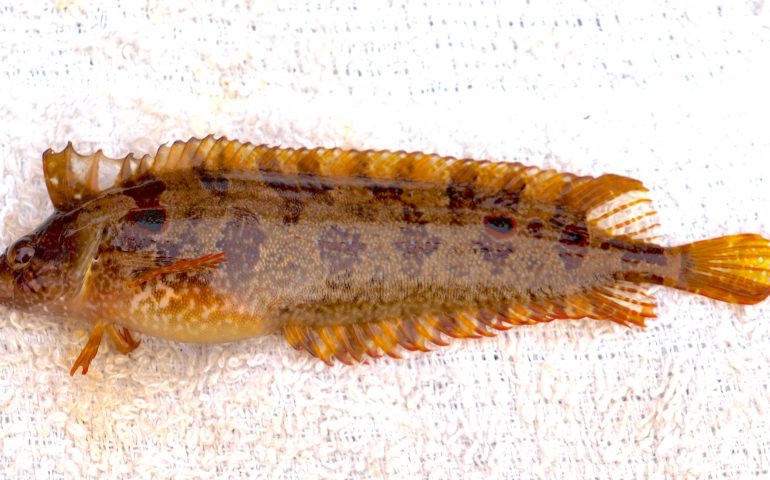Kelpfishes and Fringeheads: Family Clinidae
Species: Gibbonsia elegans (Cooper, 1864); from Gibbonsai (William P. Gibbons, an early naturalist from Alameda), and the Latin word elegans (elegant or handsome).
Alternate Names: Called Sargacero or Sargacero manchado in Mexico.
Identification: Typical kelpfish shape—pointed snout, tiny mouth, rounded caudal fin, and long dorsal fin. Color varies widely; green to brown or tan or reddish—often blotched or streaked. 1-3 (often 2) ocelli on back. Soft rays more widely spaced toward rear of dorsal fin. Scales that extend well onto the caudal fin distinguish it from other kelpfish.
Size: To 6.3 inches long; most caught from piers are around 4-5 inches.
Range: Bahia Magdalena, southern Baja California, Isla Guadalupe southern Baja California, to Piedras Blancas Point, central California, and north to San Francisco Bay. Common from Bahia Magdalena, southern Baja California, to central California.
Habitat: Intertidal, shallow-water areas near rocks or kelp down to a depth of 185 feet; usually found in seaweed. Typically feeds on benthic (bottom level) crustaceans, small mollusks and worms, but also eats fair quantities of algae. Female lays white eggs in seaweed; male guards egg mass.
Piers: Embarcadero Marina Pier, Oceanside Harbor Pier, Cabrillo Mole in Catalina, Redondo Spotfishing Pier, Malibu Pier, and Monterey Coast Guard Pier.
Shoreline: Occasionally taken by anglers fishing in rock or kelp areas if using small hooks.
Boats: An inshore species rarely take from boats.
Bait and Tackle: Light tackle and small hooks. Preferred baits appear to be sea worms—pile worms and bloodworms, pieces of shrimp, and fresh mussels.
Food Value: Too small to be used for food.
Comments: A small fish that is rarely caught due to their small mouth. However, they are sometimes an incidental catch by perch anglers using small hooks.
